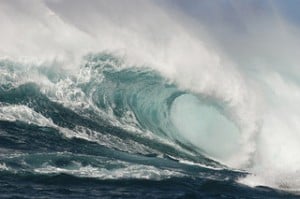
I have a confession to make. I hate the ocean. Growing up in a coastal region you would think that I would have spent my youth out on my fancy yacht, surfing the waters or deep-sea pearl diving to my hearts delight. But in all honesty, in my youth I rarely made any trips into the ocean. And the trips that were made seemed more like under-tow hopping, shark-dodging, leg-numbing wades into the black icy surf. Trying to go swimming close to where Jaws mythically took place didn’t really make the ocean any more appealing to me.
So disappointingly when I wanted to write a blog post about ocean life and climate change, I had no personal anecdotes to share about the sea, other than once I got to poke a dead seal with a stick.
But that doesn’t keep the ocean from being an incredibly cool, ever-fascinating, ecologically and economically important place that will be thoroughly altered by climate change. Just because I’m a big baby when it comes to the ocean, doesn’t mean that you all have to miss out….
As you may recall from my blog from two weeks ago, the ocean is not only going to warm with climate change, but also increase in carbon dioxide which will change the acidity of the water. Now I know all you land-mammals out there are thinking, acidity? Why should that matter? Basically this ocean acidification will make it harder for shelled animals (corals, mussels etc.) to build their shells (1) – and well, have you ever seen a naked coral before? It’s just embarrassing.
This has been observed in all sorts of shelled animals, including mussels and oysters (yum!), where calcification rates decline with increases in carbon dioxide (2).
So calcification goes down, big whoop, does this really matter for shelled-creatures?
Well this might actually change their ability to respond to predators (and I don’t mean just people, you carnivore). It turns out that the adorable Littorina littorea (aka Common Periwinkle, aka it’s a snail, duh), increases their shell thickness when they get wise to local crab predation (pretty cool, eh?). When the ocean water becomes more acidic, however, well then they aren’t able to thicken their shells making them more susceptible to crab attacks (3). And no not the type of crab attack you got after your trip to Vegas. This one is a little more life threatening, but possibly less embarrassing….
So, what is a little snail to do? Well, it turns out these slow, but wise little suckers weasel their way away from the crabs by “increasing their avoidance behavior”. In other words: run away!!!, but you know it’s a snail, so like, slowly slide away leaving some gooey trail behind you. And well anytime any animal starts to do something different, biologists have to run around waving clip-boards, Sharpie markers and NSF grants to start studying the implications on the larger ecosystem.
Will the slime the snails were eating suddenly explode in those areas where the snails have abandoned? Will the crabs have to move outside of their safety zone and risk seagull predation to get at the tasty little snails? Will the snails adapt to the change in ocean acidity and eventually move back into their old habitats? Will I ever be able to try escargot without gagging? Will I like it?
It turns out that the effects of ocean acidification on shell development in sea animals, can have all sorts of implications outside of, “gosh my shell kind of sucks” that could alter animal interactions, predation and behavior.
If you are a little sea-phobic like me, you probably didn’t give these animals much thought – who can focus on the snail at your toes when there is absolutely some evil shark waiting in the black sea to amputate your spleen? But the ocean is a place where lots of animals call home, not just the horrible ones in my head. And with climate change, many of these animals will start changing their bodies and their behavior, which can have larger implications than we think. Some of us will have to get over our fears first, to study the truly interesting changes that are occurring. Hopefully by the time we do, it won’t be too late.
Minda Berbeco has a PhD in Biology from Tufts University and is a science writer in the Bay area. For those who think that snails are boring, she encourages you to watch this video by Isabella Rosellini and then also this one from the movie Microcosms. Snails are sick, sick animals.
Further Reading:
(1) Ocean Acidification: The Other CO2 Problem
(2) Impact of elevated CO2 on shellfish calcification
(3) Ocean acidification disrupts induced defences in the intertidal gastropod Littorina littorea